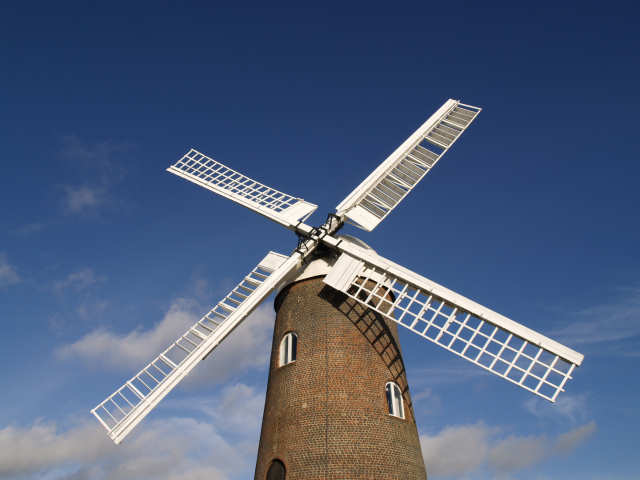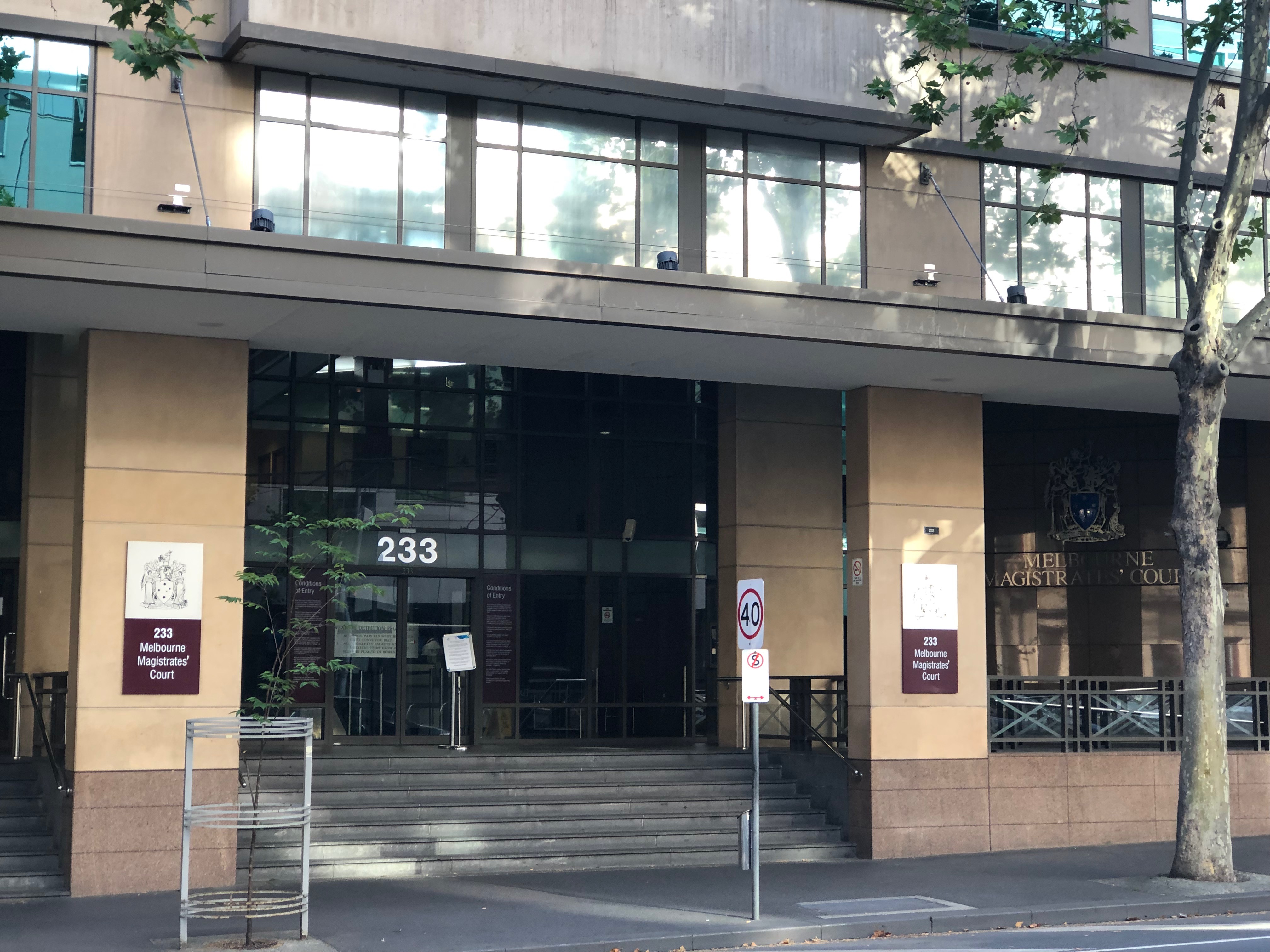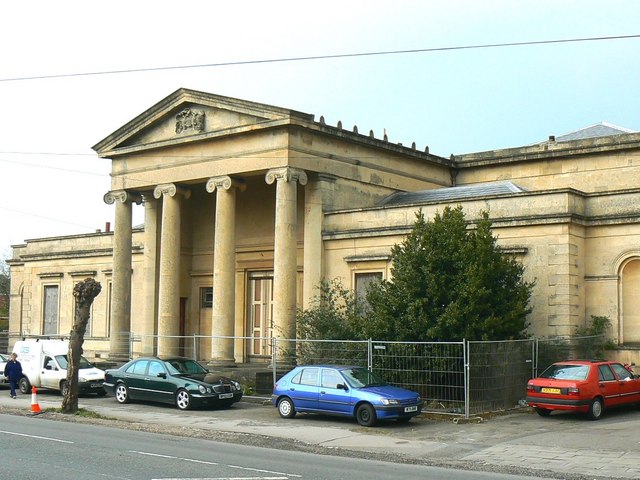|
Devizes Assize Court
Devizes Assize Court is a judicial building in Northgate Street in Devizes, a town in Wiltshire, England. The building, which is currently vacant and deteriorating, is a Grade II* listed building. History The building was designed by Thomas Henry Wyatt in the Greek Revival style, built in Bath stone and was completed in 1835. The design involved a symmetrical main frontage of 11 bays facing onto Northgate Street. The central section of three bays featured a tetrastyle portico formed by four Ionic order columns supporting an entablature and a pediment with a coat of arms in the tympanum. There was a tall double door at the back of the portico. The wings of three bays each were fenestrated by windows with cornices and, at roof level, they were surmounted by cornices and parapets. The end bays, which were recessed, contained niches and, at roof level, were also surmounted by cornices and parapets. Internally, there was a square central hall leading to the courtrooms, which had hol ... [...More Info...] [...Related Items...] OR: [Wikipedia] [Google] [Baidu] |
Devizes
Devizes is a market town and civil parish in Wiltshire, England. It developed around Devizes Castle, an 11th-century Norman castle, and received a charter in 1141. The castle was besieged during the Anarchy, a 12th-century civil war between Stephen of England and Empress Matilda, and again during the English Civil War when the Cavaliers lifted the siege at the Battle of Roundway Down. Devizes remained under Royalist control until 1645, when Oliver Cromwell attacked and forced the Royalists to surrender. The castle was destroyed in 1648 on the orders of Parliament, and today little remains of it. From the 16th century Devizes became known for its textiles, and by the early 18th century it held the largest corn market in the West Country, constructing the Corn Exchange in 1857. In the 18th century, brewing, curing of tobacco, and snuff-making were established. The Wadworth Brewery was founded in the town in 1875. Standing at the west edge of the Vale of Pewsey, the town is about ... [...More Info...] [...Related Items...] OR: [Wikipedia] [Google] [Baidu] |
Constance Kent
Constance Emily Kent (6 February 1844 – 10 April 1944) was an English woman who confessed to the murder of her half-brother, Francis Saville Kent, in 1860, when she was aged 16 and he aged three. The case led to high-level pronouncements there was no longer any ancient priest-penitent privilege in England and Wales. In later life, Kent changed her name to Ruth Emilie Kaye and lived to age 100; she served a twenty-year prison term. Early life Constance Kent was born in Sidmouth, Devon, England, in 1844, the fifth daughter and ninth child of Samuel Saville (or Savill) Kent (1801–1872), an Inspector of Factories for the Home Office, and his first wife Mary Ann (1808–1852), daughter of prosperous coachmaker and expert on the Portland Vase, Thomas Windus, FSA, of Stamford Hill, London. Crime Sometime during the night of 2930 June 1860, Francis Saville Kent, who was almost four years old, disappeared from his father's residence, Road Hill House, in the village of Rode ( ... [...More Info...] [...Related Items...] OR: [Wikipedia] [Google] [Baidu] |
Former Courthouses In England
A former is an object, such as a template, gauge or cutting die, which is used to form something such as a boat's hull. Typically, a former gives shape to a structure that may have complex curvature. A former may become an integral part of the finished structure, as in an aircraft fuselage, or it may be removable, being using in the construction process and then discarded or re-used. Aircraft formers Formers are used in the construction of aircraft fuselage, of which a typical fuselage has a series from the nose to the empennage, typically perpendicular to the longitudinal axis of the aircraft. The primary purpose of formers is to establish the shape of the fuselage and reduce the column length of stringers to prevent instability. Formers are typically attached to longerons, which support the skin of the aircraft. The "former-and-longeron" technique (also called stations and stringers) was adopted from boat construction, and was typical of light aircraft built until the a ... [...More Info...] [...Related Items...] OR: [Wikipedia] [Google] [Baidu] |
Grade II* Listed Buildings In Wiltshire (H–O)
There are over 20,000 Grade II* listed buildings in England. This article comprises a list of these buildings in the county of Wiltshire. List See also *List of Grade I listed buildings in Wiltshire This is a list of Grade I listed buildings in Wiltshire, England, in the United Kingdom. These buildings are protected for their historic significance. There is a parallel system for ancient monuments, known as 'scheduling', which means that th ... Notes External links {{DEFAULTSORT:Grade II listed buildings in Wiltshire (J-Q) ... [...More Info...] [...Related Items...] OR: [Wikipedia] [Google] [Baidu] |
Purcell (architects)
Purcell is a British architectural design practice, founded in 1947 by Donovan Purcell. It has 11 regional studios in the UK and four studios in the Asia Pacific region. History In 1947, Donovan Purcell set up a small practice in Bury St Edmunds. Working on church and army buildings for many years, Purcell developed his expertise in conservation and in 1960 was appointed Surveyor to the Fabric of Ely Cathedral. In 1965, Purcell partnered with architects Peter Miller and William “Bill” Tritton and the practice of Purcell, Miller and Tritton was established. Three years later, the partnership registered with offices in Bethel Street, Norwich and Sydney Street, London. Over the years, the practice set up studios across the UK to provide strong regional coverage. The practice rebranded as Purcell in 2012 and expanded, opening studios in Cardiff, Manchester, Newcastle and Nottingham. Purcell acquired Worcester-based architect S T Walker and Duckham in 2015 and merged with N ... [...More Info...] [...Related Items...] OR: [Wikipedia] [Google] [Baidu] |
National Lottery Heritage Fund
The National Lottery Heritage Fund, formerly the Heritage Lottery Fund (HLF), distributes a share of National Lottery funding, supporting a wide range of heritage projects across the United Kingdom. History The fund's predecessor bodies were the National Land Fund, established in 1946, and the National Heritage Memorial Fund, established in 1980. The current body was established as the "Heritage Lottery Fund" in 1994. It was re-branded as the National Lottery Heritage Fund in January 2019. Activities The fund's income comes from the National Lottery which is managed by Camelot Group. Its objectives are "to conserve the UK's diverse heritage, to encourage people to be involved in heritage and to widen access and learning". As of 2019, it had awarded £7.9 billion to 43,000 projects. In 2006, the National Lottery Heritage Fund launched the Parks for People program with the aim to revitalize historic parks and cemeteries. From 2006 to 2021, the Fund had granted £254million ... [...More Info...] [...Related Items...] OR: [Wikipedia] [Google] [Baidu] |
Wiltshire Museum
The Wiltshire Museum, formerly known as Wiltshire Heritage Museum and Devizes Museum, is a museum, archive and library and art gallery in Devizes, Wiltshire, England. The museum was established and is run by the Wiltshire Archaeological and Natural History Society (WANHS), a registered charity founded in 1853. After the purchase of an old grammar school the museum was opened in 1873. Subsequently, it expanded into two Georgian houses on either side and still occupies this location today. The museum maintains a collection covering the archaeology, art, history and natural history of Wiltshire. This collection covers periods of history from as far back as the Palaeolithic and also includes Neolithic, Bronze Age, Roman, Saxon, Mediaeval and more recent historical artefacts. Among the prehistoric collections are items from the Stonehenge and Avebury World Heritage Site. Several of the collections have been designated as being a significant part of England's cultural herit ... [...More Info...] [...Related Items...] OR: [Wikipedia] [Google] [Baidu] |
Wiltshire Historic Buildings Trust
The Wiltshire Historic Buildings Trust (founded in 1967, sometimes abbreviated WHBT) is a charitable organisation which works to preserve the architectural heritage of Wiltshire, in the West of England. History The Trust was formed in 1967, its purpose being "to preserve property and buildings of architectural and historical interest in the county for the benefit of the nation". It is both a registered charity and a company limited by guarantee. The money employed by the Trust originated in a single grant made at the time of its foundation by the former Wiltshire County Council, funding which has been described by the Trust's President Lord Lansdowne as "a revolving capital sum". Since 1967, the Trust has been instrumental in a number of projects for the restoration and conversion of historic buildings large and small. At the end of a project, the restored building is sold, so that the Trust can recover the money laid out and look for a new project. The restoration projects of ... [...More Info...] [...Related Items...] OR: [Wikipedia] [Google] [Baidu] |
Kennet District
Kennet was a non-metropolitan local government district in Wiltshire, England, abolished as part of the 2009 structural changes to local government in England. It was named after the River Kennet. The district was formed on 1 April 1974, under the Local Government Act 1972, by a merger of the municipal boroughs of Devizes, Marlborough, and Devizes Rural District, Marlborough and Ramsbury Rural District and Pewsey Rural District. The district council was based at offices in Devizes. It was abolished on 1 April 2009 as part of the 2009 structural changes to local government in England, when its functions were taken over by the new Wiltshire Council unitary authority. See also * Kennet local elections *2007 Kennet District Council election Elections to Kennet District Council were held on 3 May 2007. The whole council was up for election, and the Conservatives comfortably retained control, winning thirty-three of the forty-three seats available. [...More Info...] [...Related Items...] OR: [Wikipedia] [Google] [Baidu] |
Lord Chancellor's Department
The Lord Chancellor's Department was a United Kingdom government department answerable to the Lord Chancellor with jurisdiction over England and Wales. Created in 1885 as the Lord Chancellor's Office with a small staff to assist the Lord Chancellor in his day-to-day duties, the department grew in power over the course of the 20th century, and at its peak had jurisdiction over the entire judicial system and a staff of over 22,000. In 2003, it was succeeded by the Department for Constitutional Affairs (now the Ministry of Justice). History The department was created in 1885 by Lord Selborne, who was the Lord Chancellor at the time. The Lord Chancellor was the only cabinet minister (other than those without portfolio) not to have a department of civil servants answerable to him, and justified the expenditure of creating a permanent department by saying that: The department was originally named the Lord Chancellor's Office, with the first employees simply being transferred from ... [...More Info...] [...Related Items...] OR: [Wikipedia] [Google] [Baidu] |
Magistrates' Court
A magistrates' court is a lower court where, in several jurisdictions, all criminal proceedings start. Also some civil matters may be dealt with here, such as family proceedings. Courts * Magistrates' court (England and Wales) * Magistrate's Court of Jersey * Magistrates' court (Hong Kong) * Magistrate's courts of Israel * Magistrate's court (South Africa) * District Court (New Zealand), replaced magistrate's courts in 1980 * District Court (Ireland), the main court of summary jurisdiction in Ireland * Magistrate's court (Russia) * Magistrate's court (Sri Lanka) Australian courts * Magistrates Court of the Australian Capital Territory * Magistrates court (Northern Territory) * Magistrates Court of Queensland * Magistrates Court of South Australia * Magistrates Court of Tasmania * Magistrates' Court of Victoria * Magistrates Court of Western Australia * Local Court of New South Wales * Federal Circuit Court of Australia (initially the Federal Magistrate's Court o ... [...More Info...] [...Related Items...] OR: [Wikipedia] [Google] [Baidu] |
Assizes
The courts of assize, or assizes (), were periodic courts held around England and Wales until 1972, when together with the quarter sessions they were abolished by the Courts Act 1971 and replaced by a single permanent Crown Court. The assizes exercised both civil and criminal jurisdiction, though most of their work was on the criminal side. The assizes heard the most serious cases, which were committed to it by the quarter sessions (local county courts held four times per year), while the more minor offences were dealt with summarily by justices of the peace in petty sessions (also known as magistrates' courts). The word ''assize'' refers to the sittings or sessions (Old French ''assises'') of the judges, known as "justices of assize", who were judges who travelled across the seven circuits of England and Wales on commissions of " oyer and terminer", setting up court and summoning juries at the various assize towns. Etymology Middle English < |






